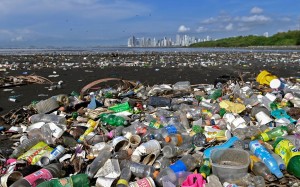>>> From an Article by Olivia Rosane, EcoWatch.com, January 18, 2022
PHOTO ~ Plastic pollution in Panama, an example of the conditions around the Earth.
Humanity is currently releasing more chemical and plastic pollution into the environment than Earth can support.
That’s the conclusion of a first-of-its-kind study published in Environmental Science and Technology on Tuesday, January 18, which argues that the planetary boundary for novel entities has been exceeded by human activity. The researchers defined “novel entities” as manufactured chemicals that do not appear naturally in large quantities and have the potential to disrupt Earth’s systems.
“There has been a 50-fold increase in the production of chemicals since 1950. This is projected to triple again by 2050,” study co-author Patricia Villarubia-Gómez from the Stockholm Resilience Centre(SRC) at Stockholm University said in a press release emailed to EcoWatch. “The pace that societies are producing and releasing new chemicals and other novel entities into the environment is not consistent with staying within a safe operating space for humanity.”
In 2009, a team of researchers identified nine planetary boundaries that have led to a stable Earth for the last 10,000 years. These include greenhouse gas emissions, the ozone layer, forests, freshwater and biodiversity. The new research builds on this foundation by quantifying the planetary boundary for novel entities.
The researchers concluded that the boundary had been breached because production and release of plastics and other chemicals now surpasses the ability of governments to assess and monitor these pollutants.
“For a long time, people have known that chemical pollution is a bad thing,” study co-author Dr. Sarah Cornell of the SRC told The Guardian. “But they haven’t been thinking about it at the global level. This work brings chemical pollution, especially plastics, into the story of how people are changing the planet.”
Scientists have previously concluded that humanity has exceeded the planetary boundaries for global heating, biodiversity loss, habitat loss and nitrogen and phosphorous pollution. The researchers noted that there are around 350,000 different types of manufactured chemicals on the global market, with almost 70,000 introduced in the last decade. Among them are plastics, pesticides, industrial chemicals and pharmaceutical products.
Plastics are especially concerning, the study authors said. They now weigh more than double the mass of living animals and around 80 percent of all the plastics ever produced persist in the environment instead of being properly recycled. Further, plastics are made up of more than 10,000 other chemicals that can enter the environment in new combinations when they degrade.
In order to address the risk posed by plastics and other chemical pollutants, the study authors argued that it is important to curb their production and release into the environment.
“We need to be working towards implementing a fixed cap on chemical production and release,” study co-author Bethanie Carney Almroth from the University of Gothenburg said in the press release.
They also supported calls for a circular economy. “That means changing materials and products so they can be reused not wasted, designing chemicals and products for recycling, and much better screening of chemicals for their safety and sustainability along their whole impact pathway in the Earth system,” Villarubia Gómez said in the press release.

